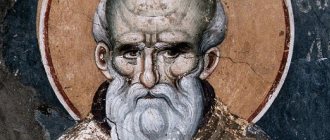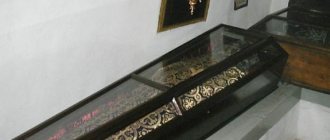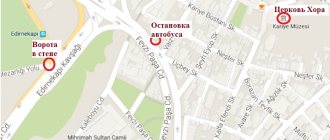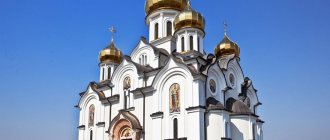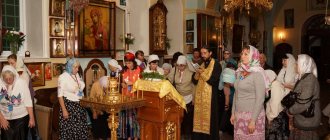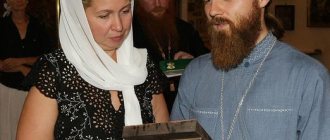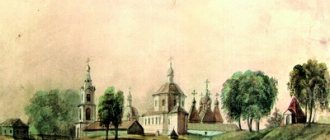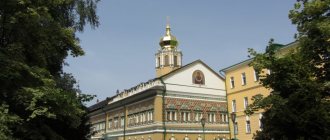Memorial Day: January 19 (February 1)
Born in Constantinople, in the family of deacon George of the Great Church. He was educated at home and at the age of 13 continued his studies with Pliphon, a famous philosophy teacher of that time. At the age of 24 he became a deacon and saccelary of St. Sophia. Emperor Manuel II made him his advisor, but he soon left the capital and became a monk.
Fleeing from the advancing Turks, he returns to Constantinople, where he becomes a kind of theological and philosophical consultant to Emperor John VIII. In 1437 he became Bishop of Ephesus and in the same year he went to the Council, which went down in history as the Ferrara-Florentine Council. The council began on April 9, 1438, and St. Mark was authorized to represent Greek theology before the Catholics. In his opinion, the time has come to restore the unity of the Church and a detailed consideration of issues of doctrine.
However, there was no free discussion at the council - the Greeks were faced with the need to accept the prevailing teaching in the West. Therefore, he begins to defend Orthodox theology, which was expressed in writing a number of treatises criticizing Catholics: “Ten Arguments against the Existence of Purgatory”, “Sum of Sayings on the Holy Spirit”
,
"Chapters against the Latins"
,
"Confession of Faith"
and
"On the Time of Transubstantiation"
.
Under strong pressure from the emperor, the Greek delegation, except Mark of Ephesus, signed the union “Laetentur coeli”. The return to Constantinople was bleak; in fact, immediately after arrival, the hierarchs who signed the union, except for a few conscious supporters, renounced their signatures. On May 15, 1440, he leaves for Ephesus, where he tries to establish church life under the rule of the Turks, and from there he continues to oppose the union, which angers John VIII. As soon as the saint found himself on Byzantine territory, he was arrested. However, even from custody he continued his polemics with the union. In 1442 he was released and returned to Constantinople. He died in 1444 after a serious illness.
Notes[ | ]
- ↑ 123456
Quoted from Archimandrite Ambrose (Pogodin). Saint Mark of Ephesus and the Union of Florence. Holy Trinity Monastery, Jordanville, NY 1963. - Mark of Ephesus
- Archimandrite Ambrose (Pogodin). Saint Mark of Ephesus and the Union of Florence
- Sylvester Syropul.
Memoirs of the Ferraro-Florence Cathedral (1438-1439). In 12 parts. - St. Petersburg: Oleg Abyshko Publishing House, University Book, 2010. - P. 241-242. — ISBN 978-5-903525-49-2. - Sylvester Syropul.
Memoirs of the Ferraro-Florence Cathedral (1438-1439). In 12 parts. - St. Petersburg: Oleg Abyshko Publishing House, University Book, 2010. - P. 253. - ISBN 978-5-903525-49-2. - Saint Mark of Ephesus. District Epistle against the Greco-Latins and the decrees of the Council of Florence
- Union of Florence. Saint Mark of Ephesus (unspecified)
(inaccessible link). Access date: May 26, 2010. Archived February 2, 2014. - Vasiliev A.A. History of the Byzantine Empire. T.2. Chapter 3. The Fall of Byzantium. Palaiologan era (1261-1451)
- John Meyendorff. Did a meeting between East and West take place in Florence?
- ↑ 1 2
Mark of Ephesus.
Message to Hieromonk Theophan on the Euboean Island - The Consecrated Cathedral completed its work
Veneration and canonization[ | ]
In 1734, under Patriarch Seraphim I of Constantinople, he was canonized by the determination of the Holy Synod of the Orthodox Church of Constantinople:
Saint Mark, called Eugenicus, former primate and pastor and bishop of the Church of Ephesus, is generally recognized as a saint in our Eastern Church of Christ and is accepted and venerated undoubtedly as the sacred father of the Church. Our Holy Christ's Eastern Church of this sacred Mark of Ephesus, Eugenics, knows and honors and joyfully accepts this holy man and God-bearing and reverend and ardent zealot of Piety and our Sacred Dogmas and right thinking, Orthodoxy's champion and most valiant defender and who previously fought in ancient times the sacred theologians and governors of the Church imitator and competitor[1].
His name was finally included in the calendar of other local Orthodox churches, including the Russian one at the end of the 20th century.
In October 2012, he was canonized by the Russian Orthodox Old Believer Church at a consecrated cathedral[11].
Theological heritage[ | ]
The theological legacy of Mark of Ephesus consists of the works he wrote during his work at the Council of Ferraro-Florence, and subsequent letters explaining his rejection of the union. In his writings as a member of the council commission, Mark sets out his analysis of Catholic theology in relation to Orthodox theology. Mark of Ephesus pointed out that in the Catholic Church a number of dogmas (for example, filioque, purgatory) are contrary to Holy Scripture and Tradition.
According to contemporaries, Mark was a brilliant speaker, but the texts of his sermons have not survived. His attempts to write an autobiography are known (“ An account of how he accepted the dignity of bishop, and an explanation of the council that took place in Florence
", "
Message to Hieromonk Theophan on the Euboean Island
"). The works of Mark of Ephesus are included in the 160th volume of the Patrologia Graeca.
On the island
Life on the island of Antigonus passed in constant tension and anxiety, in anticipation of Turkish raids. Under these conditions, it was not easy for the ascetics to remain calm, focused and silent. Therefore, together with his spiritual father, Mark returned to Constantinople, choosing the famous Mangan monastery as his place of residence. Here the spiritual elder, and subsequently Saint Mark, who valiantly ended his life, died here. In the Mangan monastery, the Saint devoted himself to strict asceticism... “...Before that, he did not like to leave the monastery and his cell in violation of silence and attention to himself, that he did not show himself even to those he knew and relatives by blood. There was only one thing he did not tire of, day or night—exercise in the divine scriptures, from which he enriched himself with an abundance of understanding, as his written corpses show.”
...Talking about the priestly ministry of St. Mark. John Eugenicus testifies: when he offered the Bloodless Sacrifice to God, he seemed all filled with light, all dedicated to God: as if taken away from the earth, as if some Angel in the flesh.
St. Mark longed for an ascetic life in solitude and silence, just as St. Gregory the Theologian, but instead the Providence of God prepared for him, as St. Gregory the Theologian, a painful struggle in the very center of church and political intrigue. From the harbor of silence of St. Mark was destined with fiery speeches, subtle and long theological syllogisms [4] to defend the Truth of Orthodox dogmas and expose errors. From the haven of ascetic hermitage, the Saint was destined to be thrown into the very storm, the very whirlpool of passions, intrigues, threats, persecution, apostasy from Orthodoxy and betrayal of the Truth taking place around him. The name of this storm and whirlpool is the Union of Florence! St. wanted one thing. Mark, the Church demanded something else from him and God’s Providence prepared for him. St. Mark was destined to be adorned not only with the glory of learning, wisdom and asceticism, but also with the crown of glorious confession. In the epitaph of St. George Scholarius says this to Mark of Ephesus: “He showed himself as another Maximus the Confessor, revealed himself through the mouth of another Gregory (Theologian).”
Symbol of faith
Only on October 8, 1438, new negotiations were opened on the most important point of disagreement between the two Churches - the question of “Filioque” (“Filioque” - “and from the Son”; Catholic teaching about the procession of the Holy Spirit not only from God the Father, but also from God the Son). The Latins insisted on examining the content of the doctrine of the “Filioque” itself, but the majority of the Greeks, led by St. Mark of Ephesus demanded a discussion of the very legality of any change in the Creed (i.e., the introduction of the “Filioque” into the content of the Creed). During the discussion, Saint Mark referred to the Decrees of the Third Ecumenical Council, which directly prohibited such changes and called on the Latins to admit their errors. However, Catholic speakers, feeling the vulnerability of their position, used various tricks to justify themselves.
No matter how obvious the Truth was, the Latins did not want to see it! The historian of the Union Syropul says that “a group of Catholic hermit monks came to listen to the debate between Orthodox and Roman Catholics on the issue of the legality of the addition “Filioque.” After listening to the speeches of both sides, these people of holy life publicly declared: “ There is no doubt, The Greeks have the true Faith and have preserved sound dogmas .” For this they were expelled, forbidden from the Pope to speak with the people, and calling them ignoramuses in theology, who do not understand anything beyond their monastic life, “they were imprisoned in a monastery, imposing silence on them.”
After many meetings, at which more than one speaker spoke, many of the Greeks came to the conclusion that negotiations with the Latins would lead nowhere and it was better to return to Constantinople.
And in fact, several members of the Greek delegation collected their luggage and went to the harbor to sail to Constantinople... Having learned about this, by order of the Emperor and Patriarch, they were caught up and, already from the ship, were returned by force. For this reason. The Emperor, having secretly agreed with the Pope, decided to move the cathedral to Florence, deep into Italy (away from the sea and the border).
False council
At the beginning of January 1439, the last meeting of the council in Ferrara took place, at which the papal bull was read about moving the council to Florence. Florence became the place where, in the words of St. Mark, the Latins dropped their masks in relation to and even in their treatment of Orthodox representatives. The Orthodox Greeks found themselves in a difficult situation: exhausted, suffering from deprivation, subjected to various persecutions, without the means to return to their homeland; aware of the terrible situation in which Byzantium finds itself. They were offered to actually “sell” the Orthodox Church and betray the Truth for generous assistance to both the state and the Greek delegates at the council themselves, even to the point of promising to direct a crusade against the Turks
Under the influence of all these circumstances, the unity of the Greek representatives, which made them strong in Ferrara, disintegrated. If in Ferrara Saint Mark of Ephesus enjoyed the support of Metropolitan Vissarion of Nicaea, and then Isidore of Moscow, and the emperor himself was on the side of the zealots of Orthodoxy, then in Florence the picture changed dramatically: the only unwavering defender of the Christian faith remains St. Mark of Ephesus. Here, in Florence, many bishops are openly (for example, Vissarion of Nicaea, Isidore of Moscow, Dorotheus of Mytilene, etc.) and secretly inclined towards Latinism... The initial desire of the Greek hierarchs to preserve Orthodoxy in all its purity and to persuade the Latins to a genuine, godly Union, convincing them that they misunderstand the dogmas in which they differ with the Orthodox, gave way to the search for compromise, half-hearted solutions and shaky dogmatic definitions and direct concessions.
“To find something in between” becomes the basis of the theological quest of the Greek representatives. But “to find something in between” was impossible, and this was clearly expressed by St. Mark, who saw that the Union represented the greatest danger to the Orthodox Church; he expressed his thought about the impossibility of “something in between” as follows: “ Can there be something in between truth and falsehood, denial and affirmation, light and darkness...”
St. Mark of Ephesus did not allow any compromise in matters of the Faith. They shouted to Mark: “Find us a way out, oikonomia.” Mark answered: “The affairs of the Faith do not allow oikonomia. It’s the same as saying: cut off your head and go wherever you want.”
The Emperor's pressure in matters of faith of St. Mark considered the matter illegal. In one of his messages he would later write: “Let no one rule in our Faith, neither a king, nor a bishop, nor a false council, nor anyone else, but
- only one God, who gave it to us,
- both Himself and through His disciples.
Here, in Florence, Saint Mark worked hard and gloriously, although he remained alone, to refute the Latin dogma “Filioque.”
- both about its illegal inclusion in the Creed and its dogmatic inconsistency,
- having compiled solid theological and dogmatic works based on the Holy Scriptures and the works of the holy Fathers of the first millennium.
Scriptures of St. Mark is characterized by theological clarity and uncompromisingness. The saint asserts that “what pertains to the Church and Faith is never, in any way, resolved through compromise,” and also stated that issues of Faith cannot be decided by voting.
Compromise in matters of the Faith of St. Mark considered death, and “violation of the Right Faith is a common death...”
There were many meetings and debates, but the Latins openly showed that their subject (conversations) was not the search for Truth, but “only (for this purpose they agreed to discussions) so that it would seem that they were saying something and occupying their ears in order to nullify, using counterfeit books and distorted sayings of the Holy Fathers, what was said by the Orthodox side.” Latin theologians behaved during the debates in such a way that they unwittingly confirmed the words once spoken by Basil the Great: “They do not know the truth and do not even want to know anything about it.”
And then St. Mark continues: “To say this (i.e., about the Truth) seemed to be singing to deaf ears, or boiling a stone, or sowing on a stone, or writing on water, or other similar things that are said in proverbs regarding the impossible.”
The Latins demanded from the Greeks the complete acceptance of Latin teaching in everything and complete submission to the Vatican... At the Council in Florence, they sought not agreement, but complete surrender of the Orthodox Church; not so much the restoration of the former unity of the Church, but rather the unconditional surrender of the Eastern Church. Pope Eugene IV was a man of exceptional willpower and statesmanship, a great politician who knew how to subjugate and break the opposition...
Emperor's Fear
Here we will make a small digression to clarify the current political situation during the life of St. Brand.
After the separation of the Latin Church from the Orthodox Eastern Church, the emperors of Constantinople and the popes of Rome repeatedly planned to unite the divided Churches, but this unification was never carried out. For both emperors and popes did not think about the truth of the Faith and the unity of the Church of Christ. The emperors thought about unity in order to ensure protection from external enemies through the political means of the popes, and the popes thought about subordinating the Orthodox Eastern Church to the Latin Church. Therefore, starting from the 12th century, various attempts were made many times to unite the Eastern and Western Churches.
And in our case, as regards the life and work of St. Mark, the main reason for convening the false council in Ferrarra and Florence was the fear that seized both the Emperor of Constantinople and the Bishop of Rome, and not at all zeal for God and Truth. For the first wanted to prevent the danger looming over his state, and the second was afraid of the Basel Council. After all, the Council of Basel rebelled more powerfully than all previous councils in the West against the absolute and infallible power of the Pope. So Emperor John VIII Palaiologos and Pope Eugene IV convened a council in Florence, thinking not about the true unity of the Churches, but about helping everyone against his enemies (although Pope Eugene also cherished hope and, as we will see, did a lot to subjugate the Orthodox Church to himself) [ 5].
Prayers
Troparion, tone 8
Orthodoxy is a teacher, / an anti-combatant of innovations, / a degree of faith, / a lamp of the Church, / a divinely inspired press of teachers, / Marco of all things, / with your writings you have enlightened all things, / the spirit of the soul Earnestly,/ pray to Christ God// for our souls to be saved.
Greek troparion, tone 3
[5]
By confession of the divine faith/ greatness you will find the Church of the zealot,/ the divine Marco of all valor,/ the champion of the fatherly wisdom/ and the destroyer of the darkness of exaltation./ Moreover, the abandonment of Christ God pray ́// grant to us, who magnify you
.
Kontakion, tone 8
The theologians of the God-wise scriptures, / as the God-spreader is true, received into the hearts, / you announced the procession of the Holy Spirit, as it should be, ever praised, / and the All-Holy One sealed it This is the Symbol, / for this reason we sing: / Rejoice, Marko Bogoglagoliv.
Kontakion, tone 4
With the wisdom of your weaving words, O all-blessed one, / you stopped every blasphemous mouth / and you enlightened the faithful with the revelation of God / / the honor of the Trinity in the identity of nature.
